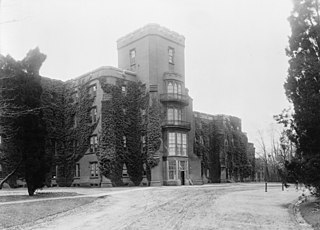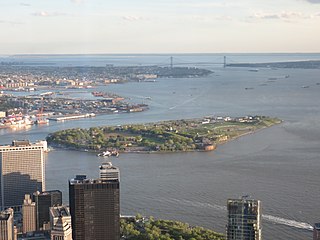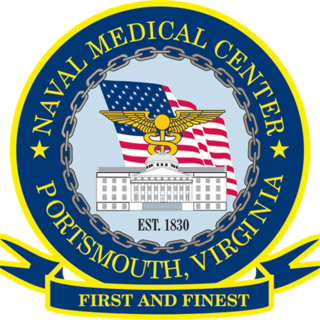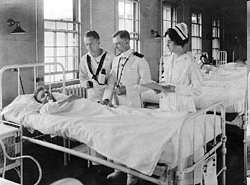
Puget Sound Naval Shipyard, officially Puget Sound Naval Shipyard and Intermediate Maintenance Facility, is a United States Navy shipyard covering 179 acres (0.7 km²) on Puget Sound at Bremerton, Washington in uninterrupted use since its establishment in 1891; it has also been known as Navy Yard Puget Sound, Bremerton Navy Yard, and the Bremerton Naval Complex.

St. Elizabeths Hospital is a psychiatric hospital in Southeast, Washington, D.C. operated by the District of Columbia Department of Behavioral Health. It opened in 1855 with the name Government Hospital for the Insane, the first federally operated psychiatric hospital in the United States. Housing over 8,000 patients at its peak in the 1950s, the hospital had a fully functioning medical-surgical unit, a school of nursing, accredited internships and psychiatric residencies. Its campus was designated a National Historic Landmark in 1990. The west portion of the campus is home to over 1,000 U.S. Department of Homeland Security personnel and serves as its headquarters. St. Elizabeth's Hospital campus also has the joint tenant of the Douglas A. Munro Coast Guard Headquarters Building with hundreds of Coast Guard personnel.

Green-Wood Cemetery is a 478-acre (193 ha) cemetery in the western portion of Brooklyn, New York City. The cemetery is located between South Slope/Greenwood Heights, Park Slope, Windsor Terrace, Borough Park, Kensington, and Sunset Park, and lies several blocks southwest of Prospect Park. It is generally bounded by 20th Street to the northeast, Fifth Avenue to the northwest, 36th and 37th Streets to the southwest, Fort Hamilton Parkway to the south, and McDonald Avenue to the east.

The Boston Navy Yard, originally called the Charlestown Navy Yard and later Boston Naval Shipyard, was one of the oldest shipbuilding facilities in the United States Navy. It was established in 1801 as part of the recent establishment of the new U.S. Department of the Navy in 1798. After 175 years of military service, it was decommissioned as a naval installation on 1 July 1974.

Governors Island is a 172-acre (70 ha) island in New York Harbor, within the New York City borough of Manhattan. It is located approximately 800 yards (732 m) south of Manhattan Island, and is separated from Brooklyn to the east by the 400-yard-wide (370 m) Buttermilk Channel. The National Park Service administers a small portion of the north of the island as the Governors Island National Monument, including two former military fortifications named Fort Jay and Castle Williams. The Trust for Governors Island operates the remaining 150 acres (61 ha), including 52 historic buildings, as a public park. About 103 acres (42 ha) of the land area is fill, added in the early 1900s to the south of the original island.

The Washington Navy Yard (WNY) is the former shipyard and ordnance plant of the United States Navy in Southeast Washington, D.C. It is the oldest shore establishment of the U.S. Navy.

Steiner Studios is a film studio at Brooklyn Navy Yard in Brooklyn, New York City. It is the largest film and television production studio complex in the United States outside Hollywood. Steiner Studios, spread across 20 acres (8.1 ha), contains 17 soundstages as well as additional support space.

1 Wall Street Court is a residential building in the Financial District of Manhattan in New York City. The 15-story building, designed by Clinton and Russell in the Renaissance Revival style, was completed in 1904 at the intersection of Wall, Pearl, and Beaver Streets.

Quarters A, also known as the Commandant's House, is a historic house on Evans Street in the Vinegar Hill neighborhood of Brooklyn, New York City. Built beginning in 1805, with a number of later alterations, it remains a prominent example of Federal architecture in New York City. It was designated a National Historic Landmark in 1974 for its association with Matthew C. Perry, commandant of the adjacent Brooklyn Navy Yard 1841–1843, whose opening of Japan to the west in 1854 revolutionized trade and international affairs. The building is now privately owned.

Admiral's Row was a row of ten homes formerly used by naval officers in the New York City borough of Brooklyn at the Brooklyn Navy Yard, and owned by the National Guard of the United States. The houses were built between 1864 and 1901.

The Naval Medical Center Portsmouth (NMCP), formerly Naval Hospital Portsmouth, and originally Norfolk Naval Hospital, is a United States Navy medical center in Portsmouth, Virginia, United States. It is the oldest continuously running hospital in the Navy medical system.

Naval Hospital Boston was a hospital in Chelsea, Massachusetts. With the closure of the nearby Boston Navy Yard, the hospital closed in 1974.

The Brooklyn Navy Yard is a shipyard and industrial complex located in northwest Brooklyn in New York City, New York. The Navy Yard is located on the East River in Wallabout Bay, a semicircular bend of the river across from Corlears Hook in Manhattan. It is bounded by Navy Street to the west, Flushing Avenue to the south, Kent Avenue to the east, and the East River on the north. The site, which covers 225.15 acres (91.11 ha), is listed on the National Register of Historic Places.

The Governor's House, also known as Building 2, is a historic house on Governors Island in New York City. It was added to the National Register of Historic Places in 1973.

The Charleston Naval Hospital Historic District is a portion of the Charleston Navy Base that included a collection of buildings connected with the medical needs of the Navy base.

The W New York Union Square is a 270-room, 21-story boutique hotel operated by W Hotels at the northeast corner of Park Avenue South and 17th Street, across from Union Square in Manhattan, New York. Originally known as the Germania Life Insurance Company Building, it was designed by Albert D'Oench and Joseph W. Yost and built in 1911 in the Beaux-Arts style.

Public School 9 and Public School 9 Annex are two historic school buildings located at 249 and 251 Sterling Place, respectively, at Vanderbilt Avenue in the Prospect Heights neighborhood of Brooklyn, New York City.
This is a timeline and chronology of the history of Brooklyn, New York. Brooklyn is the most populous of New York City's boroughs, and was settled in 1646.

Tingey House, officially known as Quarters A, is the official residence of the Chief of Naval Operations of the United States Navy. Built in 1804, it is located at the Washington Navy Yard in Washington, D.C., and is part of the Yard's historic Officers Quarters. The residence is known as Tingey House in honor of its first resident, former U.S. Navy officer Thomas Tingey. According to popular legend, Tingey's ghost haunts the property.

The Hospital Reservation Historic District is located between Radio Station and Officers Row Historic Districts and east of the Marine Reservation Historic District of the Puget Sound Naval Shipyard in Washington. Established in 1909, it reached its maximum development in 1942. The following structures no longer remain:
- ‘"Main Hospital Building"’ (1911,1924): a Neo-Classical, two story with basement brick complex.
- "’Recreation building"’ (1920): two story vernacular wood frame structure with basement; to the west was a yard cemetery, which was relocated to the Presidio in San Francisco, California.
- "’Navy Female Nurse Corps Quarters"’ (1921) was a two-story wood frame structure.
- "’Three Isolation Buildings"’ (1915) were located of the main hospital. Along with other buildings constructed here, all but one isolation building were eventually connected to the main hospital building.





















